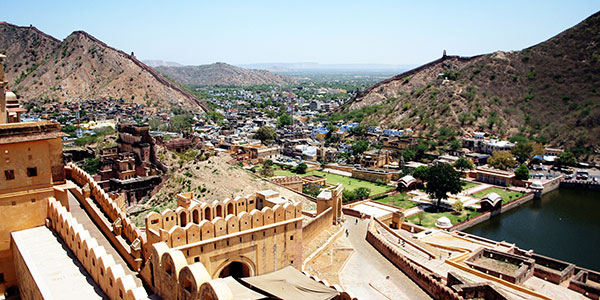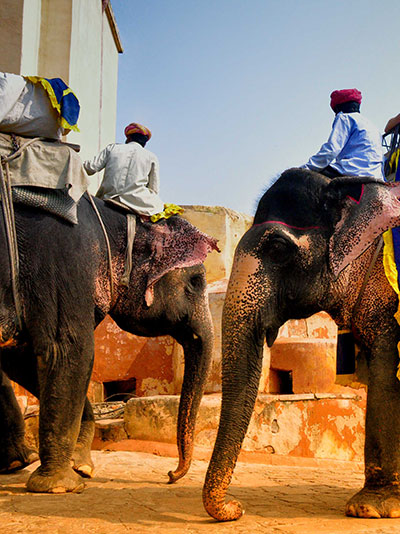
Discover The Pink City Of Jaipur
Known as the Pink City due to the colour of its buildings, Jaipur is the capital of the Rajasthan state. An exciting city rich with experiences, there are many jewels to be found amongst the chaos.
Amber Fort is arguably the city’s star attraction. Built in the 16th century, it resides high on a hill overlooking Maota Lake and is made up of towering walls, gates and cobbled paths. Its red and white sandstone is just one of the many examples why Jaipur is recognised as the Pink City. The most important parts of the fort are Diwaan-e-Aam, Diwaan-e-Khaas, Sukh Niwaas and Sheesh Mahal for their intricate beauty, design and royal use. However, the main reason why Amber Fort is so popular with visitors is that you can take an elephant ride up the hill to the main entrance. Decorated with traditional patterns, it’s an unforgettable experience as they make their way up the steep slope.

Jaigarh Fort is connected to Amber Fort. Originally built to protect Amber Fort in 1726, it’s surrounded by large battlements, lush greenery and boasts 360-degree views of Jaipur. Standing on a cliff edge, it’s a symbol of the city’s defence from war and rivals, housing the world’s largest canon on wheels and armoury. Rumour has it, the fort was also holding treasure buried beneath the grounds.
The third fort to form a defence around Jaipur is Nahargarh Fort, meaning Abode Of Tigers. Built in the Aravalli Hills in 1734, you can get one of the best views of the city here. The fort was renovated in 1868, but is still connected to Jaigarh Fort by an extended wall.

Home of the Jaipur Royal Family, the City Palace was completed in 1732 and is a prime example of Rajput palace tradition and regional style. The use of columns, arches and balconies are symbolic with Rajput, while the murals, lattice and mirrors are very Mughal. Enter through one of several gates, including Udai Pol, Jaleb Chowk, Tripolia Gate and Virendra Pol.
You could get lost staring at Hawa Mahal. Built in 1799 and translated to Palace of the Winds, it is a great wall made of pink sandstone that resembles a honeycomb hive. Towering five stories high, its
main purpose was to provide the royal ladies of the City Palace a view of everyday life and royal processions through the windows without being seen from below.

Away from the glitz of the palaces and forts is Jantar Mantar, an astronomical observation site. Built in the early 18th century by keen astrologer, Maharaja Jai Singh II, along with four others in New Delhi, Ujjan, Varanasi and Mathura, it is the largest of the five, housing 20 handmade instruments including the biggest sundial in the world, the Samrat Yantra.
You can see all of this incredible architecture and more in Jaipur on the Grand Heritage India Tour and Best Of India Tour with Travel & Taste. Exclusive to BBM readers, these tours are perfect for anyone that wants to travel through India comfortably at an affordable price, with hotel accommodation, a local guide and unique experiences. The Grand Heritage Tour is 15 days at $999pp based on two people sharing an AC medium-sized car or $1499 for one person using an AC medium-sized car. The Best Of India Tour is 11 days at $899pp based on two people sharing an AC medium-sized car or $1459 for one person using an AC medium-sized car.
These tours are available exclusively to BBM readers and won’t be found on travelandtaste.com.au. For full details ring +61 (0) 438 517 598 or email [email protected]
Read more about Travel & Taste here
Enquire About A Travel & Taste Tour
Images courtesy of Marc Hoffmann, Rod Waddington and Ziaur Rahman
